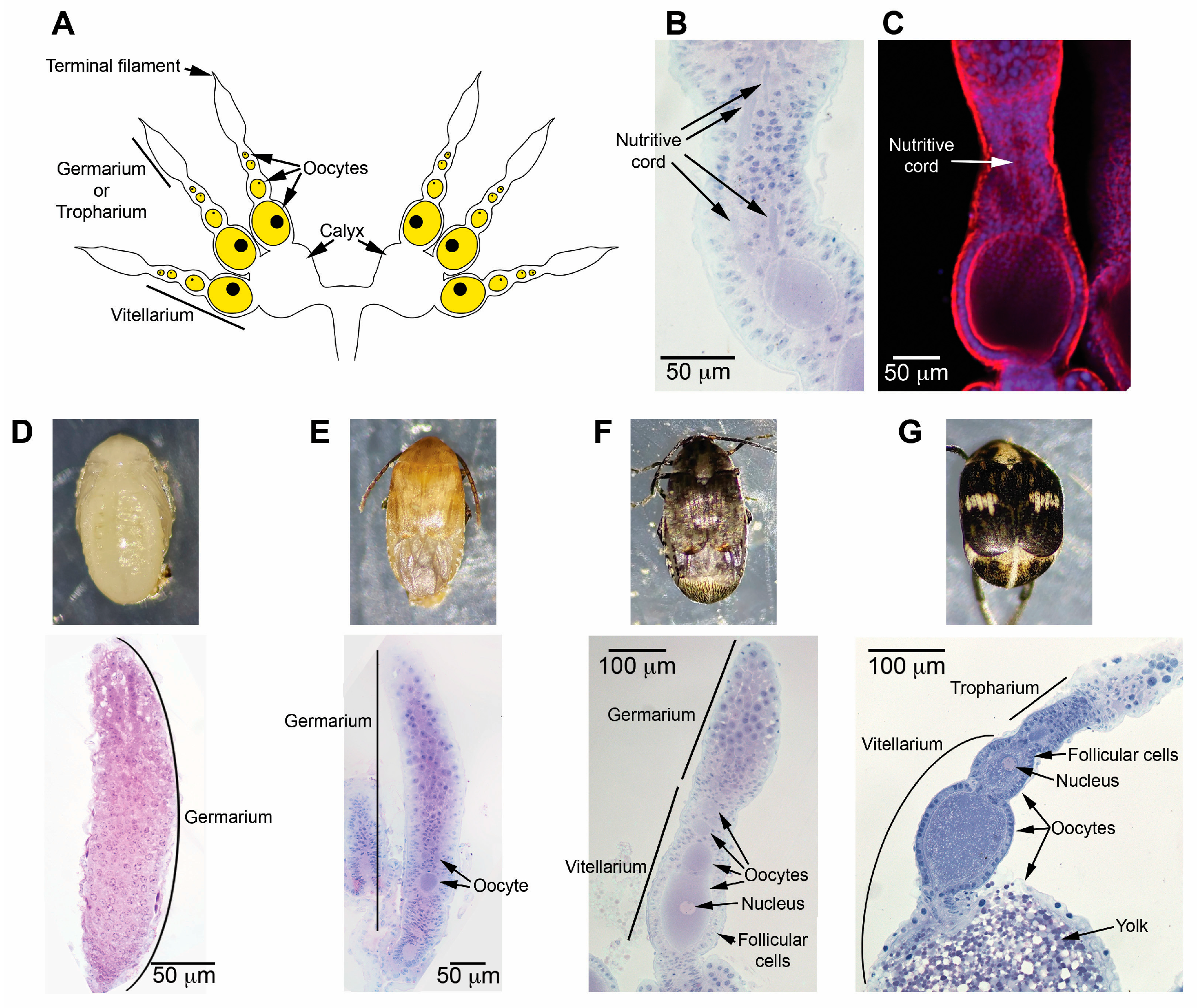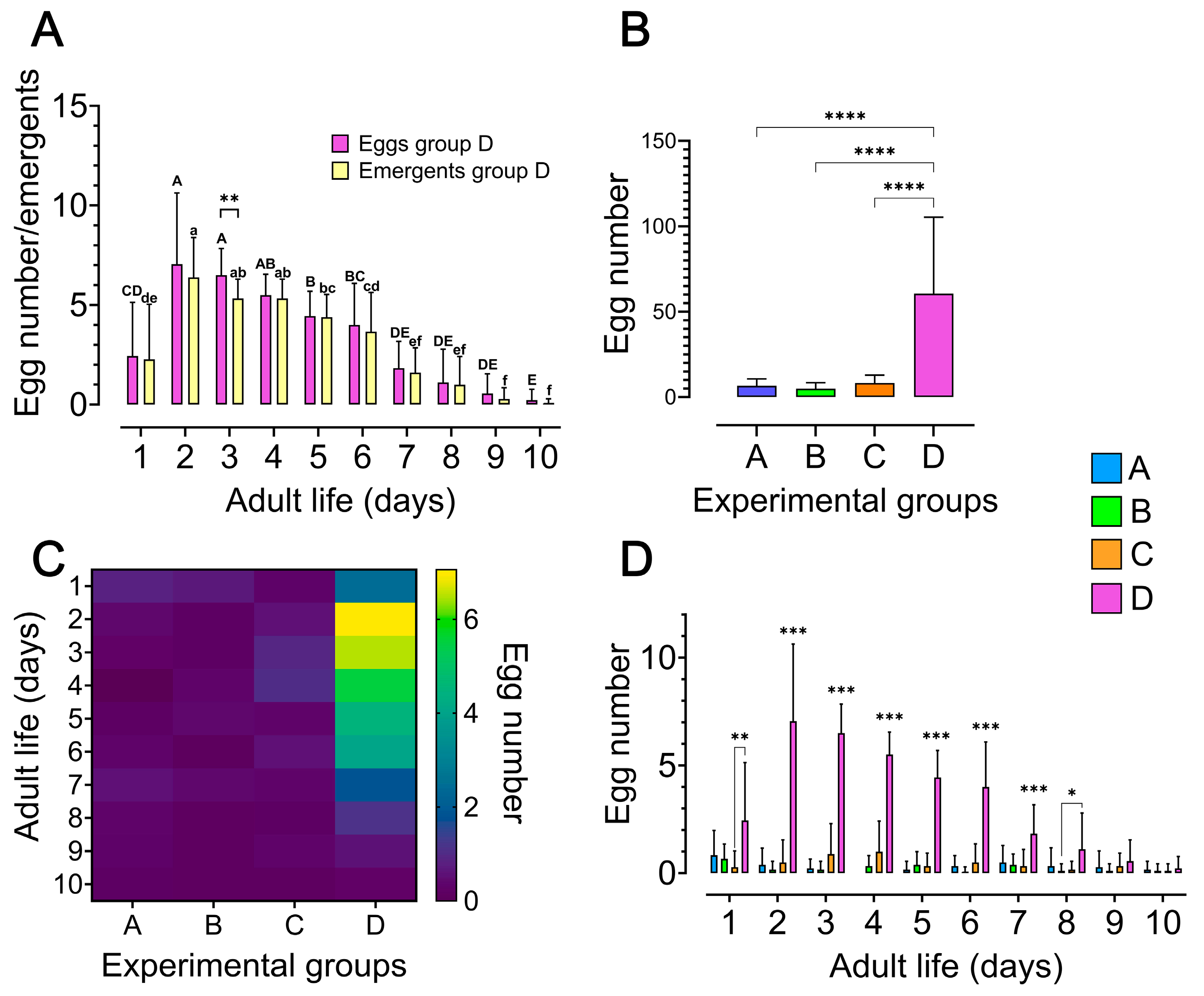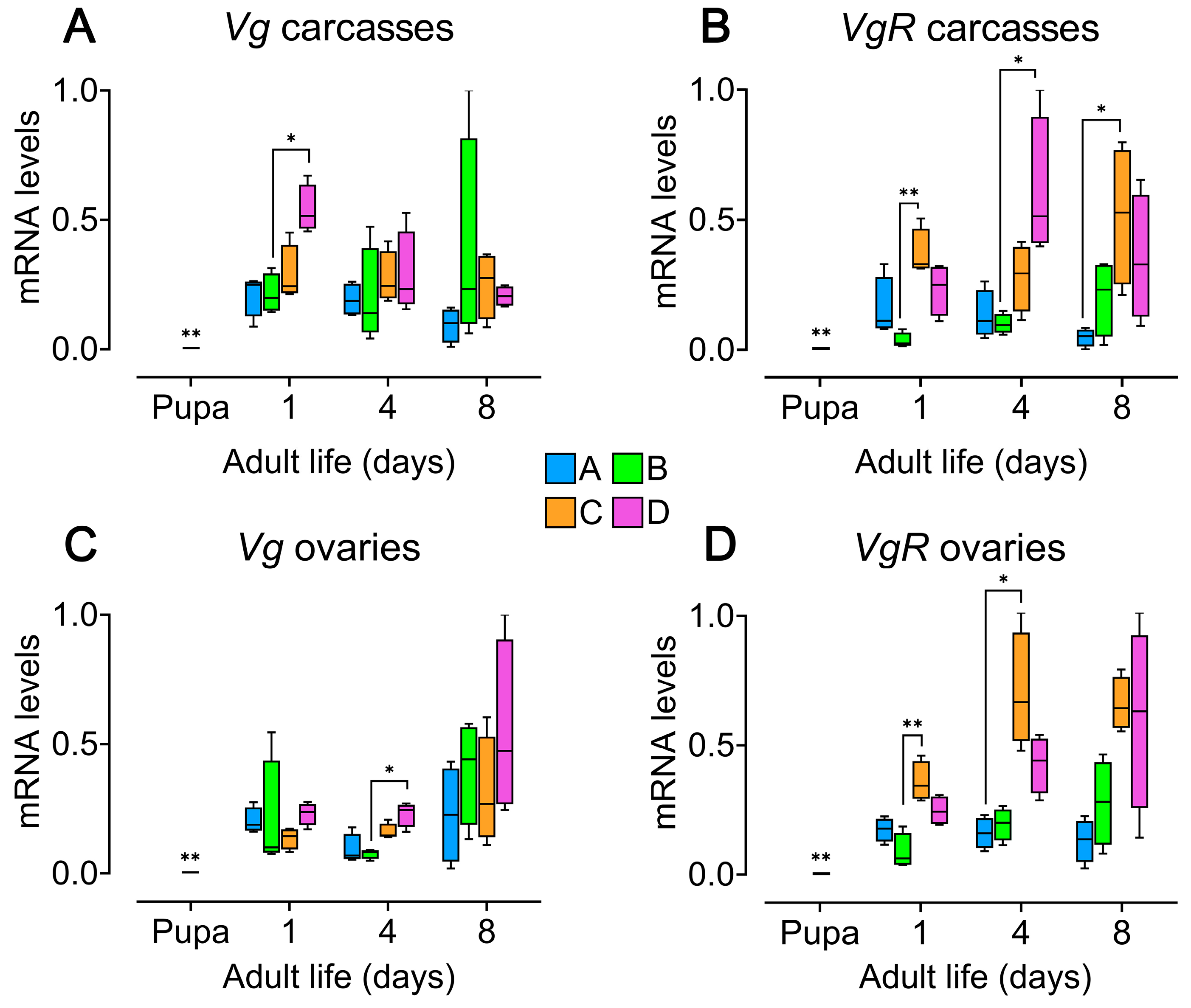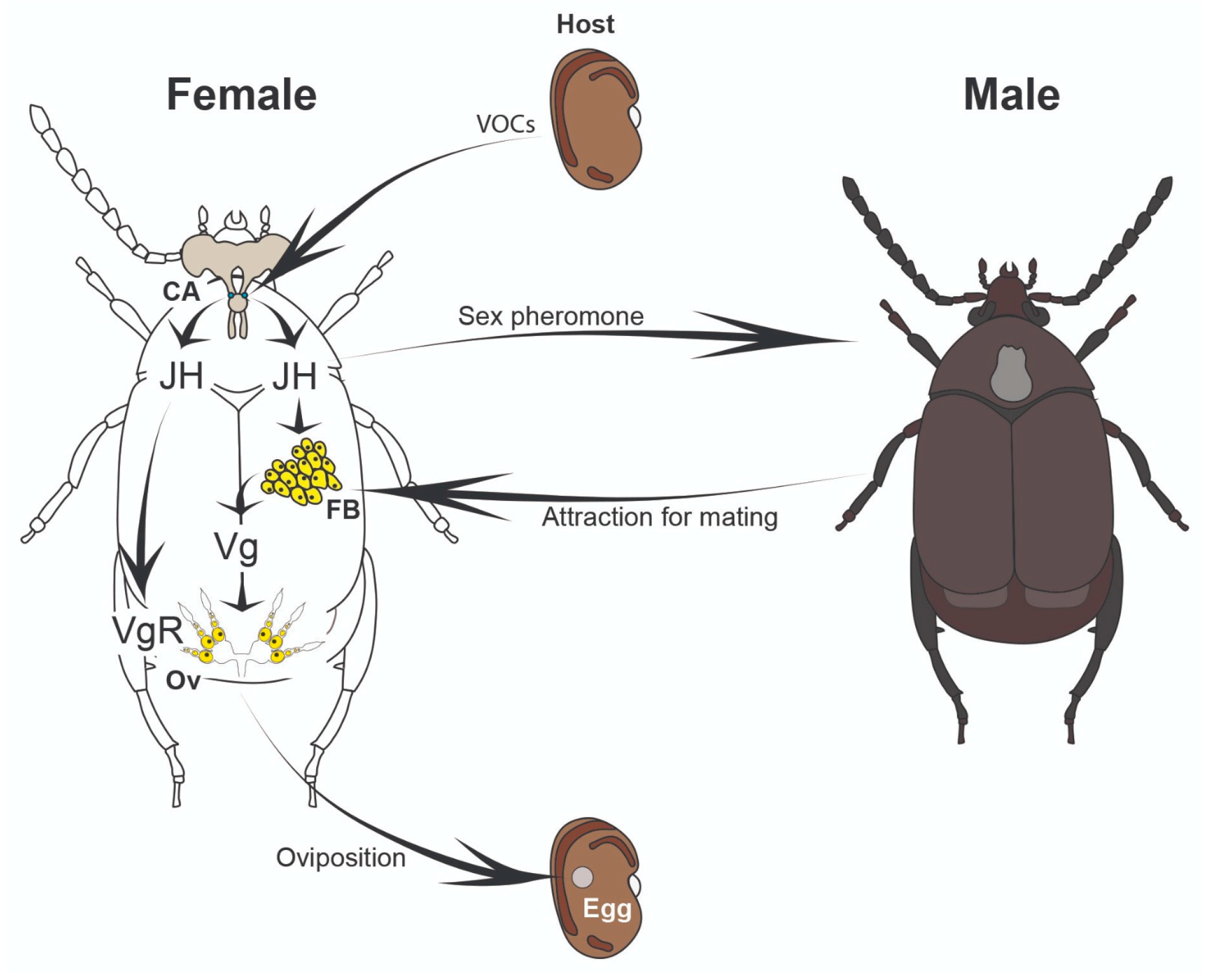Ovary Activation Dynamics in the Bean Weevil Zabrotes subfasciatus (Bruchinae): The Essential Roles of Seeds and Males
Simple Summary
Abstract
1. Introduction
2. Materials and Methods
2.1. Beetle Husbandry
2.2. Histological Processing of Pupal and Adult Ovaries
2.3. Experimental Group Allocation: Groups A, B, C, and D
2.3.1. Assessment of the Oviposition and Fecundity Profiles
2.3.2. Dissection of Adult Ovaries, Fluorescent Staining, and Scoring of Ovariole Activation
2.3.3. Quantification of Vitellogenic Genes Transcript Levels Using RT-qPCR
2.4. Data Analysis
3. Results
3.1. Female Zabrotes subfasciatus Begin Vitellogenesis During the Final Phases of Adult Development
3.2. Oviposition in Zabrotes subfasciatus Begins Shortly After Adult Emergence and Is Enhanced by the Availability of Seeds and Males
3.3. Vitellogenesis Is Elevated During the Early Phase of the Oviposition Period in Zabrotes subfasciatus, and Its Duration Is Extended by the Presence of Seeds and Males
3.4. Male Presence Enhances Vitellogenin (Vg) Expression, While Seeds Boost Vitellogenin Receptor (vgR) Expression in the Ovaries of Zabrotes subfasciatus Females
4. Discussion
5. Conclusions
Supplementary Materials
Author Contributions
Funding
Data Availability Statement
Acknowledgments
Conflicts of Interest
References
- Lawrence, J.F. Coleoptera. In Synopsis and Classification of Living Organism; Parker, S.P., Ed.; MacGraw-Hill: New York, NY, USA, 1982; Volume 2, pp. 482–553. [Google Scholar]
- McKenna, D.D.; Shin, S.; Ahrens, D.; Balke, M.; Beza-Beza, C.; Clarke, D.J.; Donath, A.; Escalona, H.E.; Friedrich, F.; Letsch, H.; et al. The Evolution and Genomic Basis of Beetle Diversity. Proc. Natl. Acad. Sci. USA 2019, 116, 24729–24737. [Google Scholar] [CrossRef]
- McKenna, D.D.; Scully, E.D.; Pauchet, Y.; Hoover, K.; Kirsch, R.; Geib, S.M.; Mitchell, R.F.; Waterhouse, R.M.; Ahn, S.-J.; Arsala, D.; et al. Genome of the Asian Longhorned Beetle (Anoplophora Glabripennis), a Globally Significant Invasive Species, Reveals Key Functional and Evolutionary Innovations at the Beetle–Plant Interface. Genome Biol. 2016, 17, 227. [Google Scholar] [CrossRef] [PubMed]
- Morse, G. Bruchinae Latereille. In Arthropoda: Insecta: Coleoptera.; Handbook of Zoology; De Gruyter: Berlin, Germany, 2014; Volume 3, pp. 189–197. [Google Scholar]
- Johnson, C.D. Seed Beetle Host Specificity and the Systematics of the Leguminosae. In Advances in Legume Systematics Part 2; Polhill, R.M., Raven, P.H., Eds.; Royal Botanic Gardens, Kew: Richmond, UK, 1981; pp. 995–1007. [Google Scholar]
- Southgate, B.J. Biology of the Bruchidae. Ann. Rev. Entomol. 1979, 24, 449–473. [Google Scholar] [CrossRef]
- Diamond, J. Guns, Germs, and Steel: The Fates of Human Societies; W. W. Norton & Company: New York, NY, USA, 1997. [Google Scholar]
- Tuda, M. Evolutionary Diversification of Bruchine Beetles: Climate-Dependent Traits and Development Associated with Pest Status. Bull. Entomol. Res. 2011, 101, 415–422. [Google Scholar] [CrossRef]
- Corrêa, C.P.; Parreiras, S.S.; Beijo, L.A.; de Ávila, P.M.; Teixeira, I.R.V.; Barchuk, A.R. Life History Trait Response to Ambient Temperature and Food Availability Variations in the Bean Weevil Zabrotes subfasciatus. Physiol. Entomol. 2021, 46, 189–199. [Google Scholar] [CrossRef]
- Mesterházy, Á.; Oláh, J.; Popp, J. Losses in the Grain Supply Chain: Causes and Solutions. Sustainability 2020, 12, 2342. [Google Scholar] [CrossRef]
- Pimbert, M. A Model of Host Plant Change of Zabrotes subfasciatus Boh. (Coleoptera: Bruchidae) in a Traditional Bean Cropping System in Costa Rica. Biol. Agric. Hortic. 1985, 3, 39–54. [Google Scholar] [CrossRef]
- Pimbert, M. Reproduction and Oviposition Preferences of Zabrotes subfasciatus Stocks Reared from Two Host Plant Species. Entomol. Exp. Appl. 1985, 38, 273–276. [Google Scholar] [CrossRef]
- Fox, C.W. The Effect of Inbreeding on Natural Selection in a Seed-feeding Beetle. J. Evol. Biol. 2013, 26, 88–93. [Google Scholar] [CrossRef]
- Fox, C.W.; Waddell, K.J.; Mousseau, T.A. Host-Associated Fitness Variation in a Seed Beetle (Coleoptera: Bruchidae): Evidence for Local Adaptation to a Poor Quality Host. Oecologia 1994, 99, 329–336. [Google Scholar] [CrossRef]
- Sayadi, A.; Barrio, A.M.; Immonen, E.; Dainat, J.; Berger, D.; Tellgren-Roth, C.; Nystedt, B.; Arnqvist, G. The Genomic Footprint of Sexual Conflict. Nat. Ecol. Evol. 2019, 3, 1725–1730. [Google Scholar] [CrossRef]
- Teixeira, I.R.V.; Beijo, L.A.; Barchuk, A.R. Behavioral and Physiological Responses of the Bean Weevil Zabrotes subfasciatus to Intraspecific Competition. J. Stored Prod. Res. 2016, 69, 51–57. [Google Scholar] [CrossRef]
- Ibrahim, S.P.; Dias, R.O.; Ferreira, C.; Silva, C.P.; Terra, W.R. Histochemistry and Transcriptomics of Mucins and Peritrophic Membrane (PM) Proteins along the Midgut of a Beetle with Incomplete PM and Their Complementary Function. Insect Biochem. Mol. Biol. 2023, 162, 104027. [Google Scholar] [CrossRef] [PubMed]
- Silva, C.P.; Terra, W.R.; de Sá, M.F.G.; Samuels, R.I.; Isejima, E.M.; Bifano, T.D.; Almeida, J.S. Induction of Digestive α-Amylases in Larvae of Zabrotes subfasciatus (Coleoptera: Bruchidae) in Response to Ingestion of Common Bean α-Amylase Inhibitor 1. J. Insect Physiol. 2001, 47, 1283–1290. [Google Scholar] [CrossRef] [PubMed]
- Cruz, B.O.; de Miranda, S.O.; Benedito, E.R.C.; Martins, J.R.; Beijo, L.A.B.; Nogueira, E.S.C.; Mazzoni, T.S.; Moda, L.M.R.; do Teixeira, I.R.V.; Barchuk, A.R. Early Adaptation to an Unusual Host in the Bean Weevil Zabrotes subfasciatus Is Associated with Changes in Body Size and Reproductive Physiology. Physiol. Entomol. 2025. [Google Scholar]
- Rodrigues, P.A.P.; Martins, J.R.; Capizzani, B.C.; Hamasaki, L.T.A.; Simões, Z.L.P.; do Teixeira, I.R.V.; Barchuk, A.R. Transcriptional Signature of Host Shift in the Seed Beetle Zabrotes subfasciatus. Genet. Mol. Biol. 2024, 47, e20230148. [Google Scholar] [CrossRef]
- Teixeira, I.R.V.; Barchuk, A.R.; Zucoloto, F.S. Host Preference of the Bean Weevil Zabrotes subfasciatus. Insect Sci. 2008, 15, 335–341. [Google Scholar] [CrossRef]
- Love, A.C.; Yoshida, Y. Reflections on Model Organisms in Evolutionary Developmental Biology. In Evo-Devo: Non-model Species in Cell and Developmental Biology; Springer: Berlin/Heidelberg, Germany, 2019; pp. 3–20. [Google Scholar]
- Valencia, C.A.; Mejía, C.C.; van Schoonhoven, A. Main Insect Pests of Stored Beans and Their Control [Tutorial Unit]; Centro Internacional de Agricultura Tropical (CIAT): Palmira, Colombia, 1986. [Google Scholar]
- Teixeira, I.R.V.; Gris, C.F. Genetic Diversity of Grains, Storage Pests and Their Effects on the Worldwide Bean Supply. In Beans: Nutrition, Consumption and Health; Popescu, E., Golubev, I., Eds.; Nova Science Publishers: New York, NY, USA, 2011. [Google Scholar]
- Boheman, C.H. Genera et Species Curculionidum, Cum Synonymia Hujus Familiae. In Synonymia Insectorum, Oder: Versuch Einer Synonymie Aller Bisher Bekannten Insecten; Nach Fabricii Systema Eleutheratorum & c. Geordnet; Schoenherr, C.J., Ed.; Roret: Paris, France, 1833. [Google Scholar]
- Schoch, C.L.; Ciufo, S.; Domrachev, M.; Hotton, C.L.; Kannan, S.; Khovanskaya, R.; Leipe, D.; Mcveigh, R.; O’Neill, K.; Robbertse, B.; et al. NCBI Taxonomy: A Comprehensive Update on Curation, Resources and Tools. Database 2020, 2020, baaa062. [Google Scholar] [CrossRef]
- Lucas, M.H. Spermophagus Semifasicatus. In Annales de la Société Entomologique de France; Société Entomologique de France: Paris, France, 1858; Serie 3; Tome 6; pp. 245–248. [Google Scholar]
- Corrêa, C.P.; Capizzani, B.C.; Beijo, L.A.; de Ávila, P.M.; do Teixeira, I.R.V.; Barchuk, A.R. Adult Feeding and Host Type Modulate the Life History Traits of the Capital Breeder Zabrotes subfasciatus. Physiol. Entomol. 2020, 45, 120–128. [Google Scholar] [CrossRef]
- Meik, J.; Dobie, P. The Ability of Zabrotes subfasciatus to Attack Cowpeas. Entomol. Exp. Et Appl. 1986, 42, 151–158. [Google Scholar] [CrossRef]
- Teixeira, I.R.V.; Zucoloto, F.S. Seed Suitability and Oviposition Behaviour of Wild and Selected Populations of Zabrotes subfasciatus (Boheman) (Coleoptera: Bruchidae) on Different Hosts. J. Stored Prod. Res. 2003, 39, 131–140. [Google Scholar] [CrossRef]
- Hodin, J. She Shapes Events as They Come: Plasticity in Female Insect Reproduction. In Phenotypic Plasticity of Insects: Mechanisms and Consequences; Science Publishers: Enfield, NH, USA, 2009; pp. 423–521. [Google Scholar]
- Soller, M.; Bownes, M.; Kubli, E. Control of Oocyte Maturation in Sexually Mature Drosophila Females. Dev. Biol. 1999, 208, 337–351. [Google Scholar] [CrossRef] [PubMed]
- Wu, Z.; Yang, L.; He, Q.; Zhou, S. Regulatory Mechanisms of Vitellogenesis in Insects. Front. Cell Dev. Biol. 2021, 8, 593613. [Google Scholar] [CrossRef] [PubMed]
- Leyria, J. Endocrine Factors Modulating Vitellogenesis and Oogenesis in Insects: An Update. Mol. Cell. Endocrinol. 2024, 587, 112211. [Google Scholar] [CrossRef]
- Delobel, A. Effect of Groundnut Pods (Arachis hypogaea) and Imaginal Feeding on Oogenesis, Mating and Oviposition in the Seed Beetle, Caryedon Serratus. Entomol. Exp. Appl. 1989, 52, 281–289. [Google Scholar] [CrossRef]
- Pouzat, J.; Bilal, H.; Nammour, D.; Pimbert, M. A Comparative Study of the Host Plant’s Influence on the Sex Pheromone Dynamics of Three Bruchid Species. Acta Oecologica Oecologia Gen. 1989, 10, 401–410. [Google Scholar]
- Papaj, D.R. Ovarian Dynamics and Host Use. Annu. Rev. Entomol. 2000, 45, 423–448. [Google Scholar] [CrossRef]
- Pimbert, M.; Pouzat, J. Electroantennogram Responses of Zabrotes subfasciatus to Odours of the Sexual Partner. Entomol. Exp. Appl. 1988, 47, 49–53. [Google Scholar] [CrossRef]
- Parsons, D.M.J.; Credland, P.F. Determinants of Oviposition in Acanthoscelides obtectus: A Nonconformist Bruchid. Physiol. Entomol. 2003, 28, 221–231. [Google Scholar] [CrossRef]
- Pimbert, M. Analysis in a Tubular Olfactometer of the Influence of Different Olfactory Stimuli on the Search for a Sexual Partner by Zabrotes subfasciatus. Entomol. Exp. Appl. 1987, 45, 23–27. [Google Scholar] [CrossRef]
- Pimbert, M.; Pierre, D. Ecophysiological Aspects of Bruchid Reproduction: The Influence of Pod Maturity and Seeds of Phaseolus vulgaris and the Influence of Insemination on the Reproductive Activity of Zabrotes subfasciatus. Ecol. Entomol. 1983, 8, 87–94. [Google Scholar] [CrossRef]
- Craddock, E.M.; Boake, C.R.B. Onset of Vitellogenesis in Female Drosophila silvestris Is Accelerated in the Presence of Sexually Mature Males. J. Insect Physiol. 1992, 38, 643–650. [Google Scholar] [CrossRef]
- Boake, C.R.B.; Moore, S. Male Acceleration of Ovarian Development in Drosophila silvestris (Diptera, Drosophilidae): What Is the Stimulus? J. Insect Physiol. 1996, 42, 649–655. [Google Scholar] [CrossRef]
- Knapp, R.A.; Norman, V.C.; Rouse, J.L.; Duncan, E.J. Environmentally Responsive Reproduction: Neuroendocrine Signalling and the Evolution of Eusociality. Curr. Opin. Insect Sci. 2022, 53, 100951. [Google Scholar] [CrossRef]
- Pereira, R.; Teal, P.E.A.; Sivinski, J.; Dueben, B.D. Influence of Male Presence on Sexual Maturation in Female Caribbean Fruit Fly, Anastrepha suspensa (Diptera: Tephritidae). J. Insect Behav. 2006, 19, 31–43. [Google Scholar] [CrossRef]
- Trumbo, S.T. Juvenile Hormone-Mediated Reproduction in Burying Beetles: From Behavior to Physiology. Arch. Insect Biochem. Physiol. 1997, 35, 479–490. [Google Scholar] [CrossRef]
- Trumbo, S.T.; Borst, D.W.; Robinson, G.E. Rapid Elevation of Juvenile Hormone Titer during Behavioral Assessment of the Breeding Resource by the Burying Beetle, Nicrophorus orbicollis. J. Insect Physiol. 1995, 41, 535–543. [Google Scholar] [CrossRef]
- Pouzat, J. Host Plant Chemosensory Influence on Oogenesis in the Bean Weevil Acanthoscelides obtectus (Coleoptera: Bruchidae). Entomol. Exp. Appl. 1978, 24, 601–608. [Google Scholar] [CrossRef]
- Li, H.-L.; Wang, X.-Y.; Zheng, X.-L.; Lu, W. Research Progress on Oviposition-Related Genes in Insects. J. Insect Sci. 2020, 20, 36. [Google Scholar] [CrossRef]
- Souza, G.A.; Carvalho, M.R.O.; Martins, E.R.; Guedes, R.N.C.; Oliveira, L.O. Diversidade Genética Estimada Com Marcadores ISSR Em Populações Brasileiras de Zabrotes subfasciatus. Pesqui. Agropecuária Bras. 2008, 43, 843–849. [Google Scholar] [CrossRef]
- Bondar, G.G. Notas Biologicas Sobre Bruchideros Observados No Brasil; Tipografia do Jornal do Commercio: Rio de Janeiro, Brasil, 1937; 49p. [Google Scholar]
- Teixeira, I.R.V.; Barchuk, A.R.; Medeiros, L.; Zucoloto, F.S. Females of the Weevil Zabrotes subfasciatus Manipulate the Size and Number of Eggs According to the Host Seed Availability. Physiol. Entomol. 2009, 34, 246–250. [Google Scholar] [CrossRef]
- Teixeira, I.R.V.; Zucoloto, F.S. Intraspecific Competition in Zabrotes subfasciatus: Physiological and Behavioral Adaptations to Different Amounts of Host. Insect Sci. 2012, 19, 102–111. [Google Scholar] [CrossRef]
- Karnovsky, M.J. A Formaldehyde Glutaraldehyde Fixative of High Osmolality for Use in Electron Microscopy. J. Cell Biol. 1965, 27, 1A–149A. [Google Scholar]
- Harris, H.F. On the Rapid Conversion of Haematoxylin into Haematein in Staining Reactions. J. Appl. Microsc. Lab. Methods 1900, 3, 777. [Google Scholar]
- Howe, R.W.; Currie, J.E. Some Laboratory Observations on the Rates of Development, Mortality and Oviposition of Several Species of Bruchidae Breeding in Stored Pulses. Bull. Entomol. Res. 1964, 55, 437–477. [Google Scholar] [CrossRef]
- Dendy, J.; Credland, P.F. Development, Fecundity and Egg Dispersion of Zabrotes subfasciatus. Entomol. Exp. Appl. 1991, 59, 9–17. [Google Scholar] [CrossRef]
- Silva, J.A.; Farder-Gomes, C.F.; Barchuk, A.R.; Malaspina, O.; Nocelli, R.C.F. Sublethal Exposure to Thiamethoxam and Pyraclostrobin Affects the Midgut and Malpighian Tubules of the Stingless Bee Frieseomelitta varia (Hymenoptera: Apidae: Meliponini). Ecotoxicology 2024, 33, 875–883. [Google Scholar] [CrossRef]
- Livak, K.J.; Schmittgen, T.D. Analysis of Relative Gene Expression Data Using Real-Time Quantitative PCR and the 2−ΔΔCT Method. Methods 2001, 25, 402–408. [Google Scholar] [CrossRef]
- GraphPad Prism, Version 10.5.0; GraphPad Software: Boston, MA, USA, 2023. Available online: https://www.graphpad.com/ (accessed on 17 July 2025).
- Sappington, T.W.; Raikhel, A.S. Molecular Characteristics of Insect Vitellogenins and Vitellogenin Receptors. Insect Biochem. Mol. Biol. 1998, 28, 277–300. [Google Scholar] [CrossRef]
- Klowden, M.J.; Pallai, S.R. Physiological Systems in Insects, 4th ed.; Academic Press, an imprint of Elsevier: London, UK; San Diego, CA, USA, 2023; ISBN 978-0-12-820359-0. [Google Scholar]
- Mohamed, M.I.; Khaled, A.S.; Fattah, H.M.A.; Hussein, M.A.; Salem, D.A.M.; Fawki, S. Ultrastructure and Histopathological Alteration in the Ovaries of Callosobruchus maculatus (F.) (Coleoptera, Chrysomelidae) Induced by the Solar Radiation. J. Basic Appl. Zool. 2015, 68, 19–32. [Google Scholar] [CrossRef]
- Aggarwal, S.K. Morphological and Histochemical Studies on Oogenesis in Callosobruchus analis Fabr. (Bruchidae-Coleoptera). J. Morphol. 1967, 122, 19–33. [Google Scholar] [CrossRef]
- Büning, J. The Telotrophic Nature of Ovarioles of Polyphage Coleoptera. Zoomorphologie 1979, 93, 51–57. [Google Scholar] [CrossRef]
- Büning, J. Ovariole Structure Supports Sistergroup Relationship of Neuroptera and Coleoptera. Arthropod Syst. Phylogeny 2006, 64, 115–126. [Google Scholar] [CrossRef]
- Belles, X.; Piulachs, M.-D. Ecdysone Signalling and Ovarian Development in Insects: From Stem Cells to Ovarian Follicle Formation. Biochim. Biophys. Acta (BBA)—Gene Regul. Mech. 2015, 1849, 181–186. [Google Scholar] [CrossRef] [PubMed]
- Jönsson, K.I.; Jonsson, K.I. Capital and Income Breeding as Alternative Tactics of Resource Use in Reproduction. Oikos 1997, 78, 57. [Google Scholar] [CrossRef]
- Katvala, M.; Rönn, J.L.; Arnqvist, G. Correlated Evolution between Male Ejaculate Allocation and Female Remating Behaviour in Seed Beetles (Bruchidae). J. Evol. Biol. 2008, 21, 471–479. [Google Scholar] [CrossRef]
- Bailly, T.P.M.; Kohlmeier, P.; Etienne, R.S.; Wertheim, B.; Billeter, J.-C. Social Modulation of Oogenesis and Egg Laying in Drosophila melanogaster. Curr. Biol. 2023, 33, 2865–2877. [Google Scholar] [CrossRef]
- Montserrat-Canals, M.; Schnelle, K.; Leipart, V.; Halskau, Ø.; Amdam, G.V.; Moeller, A.; Cunha, E.S.; Luecke, H. Cryo-EM Structure of Native Honey Bee Vitellogenin. Nat. Commun. 2025, 16, 5736. [Google Scholar] [CrossRef]
- Du, L.; Wang, M.; Li, J.; He, S.; Huang, J.; Wu, J. Characterization of a Vitellogenin Receptor in the Bumblebee, Bombus lantschouensis (Hymenoptera, Apidae). Insects 2019, 10, 445. [Google Scholar] [CrossRef]
- Melo, A.C.A.; Valle, D.; Machado, E.A.; Salerno, A.P.; Paiva-Silva, G.O.; Silva, N.L.C.E.; de Souza, W.; Masuda, H. Synthesis of Vitellogenin by the Follicle Cells of Rhodnius prolixus. Insect Biochem. Mol. Biol. 2000, 30, 549–557. [Google Scholar] [CrossRef]
- Schonbaum, C.P.; Perrino, J.J.; Mahowald, A.P. Regulation of the Vitellogenin Receptor during Drosophila melanogaster Oogenesis. Mol. Biol. Cell 2000, 11, 511–521. [Google Scholar] [CrossRef]
- Tufail, M.; Takeda, M. Molecular Cloning, Characterization and Regulation of the Cockroach Vitellogenin Receptor during Oogenesis. Insect Mol. Biol. 2005, 14, 389–401. [Google Scholar] [CrossRef] [PubMed]
- Zhao, J.; Sun, Y.; Xiao, L.; Tan, Y.; Jiang, Y.; Bai, L. Vitellogenin and Vitellogenin Receptor Gene Expression Profiles in Spodoptera exigua Are Related to Host Plant Suitability. Pest Manag. Sci. 2018, 74, 950–958. [Google Scholar] [CrossRef]
- Capizzani, B.C.; Rainho, H.L.; de Miranda, S.O.; de Rosa, V.D.S.; Beijo, L.A.; do Teixeira, I.R.V.; Bento, J.M.; Barchuk, A.R. Contrasting Responses to Ethenylbenzene (Styrene) and 2-Ethyl-1-Hexanol Suggest Their Role as Chemical Cues in Host Selection by the Seed Beetle Zabrotes subfasciatus (Coleoptera: Chrysomelidae: Bruchinae). Neotrop. Entomol. 2024, 54, 9. [Google Scholar] [CrossRef]
- Zhang, X.; Li, S.; Liu, S. Juvenile Hormone Studies in Drosophila melanogaster. Front. Physiol. 2022, 12, 785320. [Google Scholar] [CrossRef]





Disclaimer/Publisher’s Note: The statements, opinions and data contained in all publications are solely those of the individual author(s) and contributor(s) and not of MDPI and/or the editor(s). MDPI and/or the editor(s) disclaim responsibility for any injury to people or property resulting from any ideas, methods, instructions or products referred to in the content. |
© 2025 by the authors. Licensee MDPI, Basel, Switzerland. This article is an open access article distributed under the terms and conditions of the Creative Commons Attribution (CC BY) license (https://creativecommons.org/licenses/by/4.0/).
Share and Cite
Miranda, S.d.O.; Cruz, B.d.O.; Martins, J.R.; Mazzoni, T.S.; Miranda, W.d.O.; Moda, L.M.R.; Caixeta, E.S.; Teixeira, I.R.d.V.; Barchuk, A.R. Ovary Activation Dynamics in the Bean Weevil Zabrotes subfasciatus (Bruchinae): The Essential Roles of Seeds and Males. Insects 2025, 16, 894. https://doi.org/10.3390/insects16090894
Miranda SdO, Cruz BdO, Martins JR, Mazzoni TS, Miranda WdO, Moda LMR, Caixeta ES, Teixeira IRdV, Barchuk AR. Ovary Activation Dynamics in the Bean Weevil Zabrotes subfasciatus (Bruchinae): The Essential Roles of Seeds and Males. Insects. 2025; 16(9):894. https://doi.org/10.3390/insects16090894
Chicago/Turabian StyleMiranda, Sílvia de Oliveira, Bruno de Oliveira Cruz, Juliana Ramos Martins, Talita Sarah Mazzoni, Waner de Oliveira Miranda, Lívia Maria Rosatto Moda, Ester Siqueira Caixeta, Isabel Ribeiro do Valle Teixeira, and Angel Roberto Barchuk. 2025. "Ovary Activation Dynamics in the Bean Weevil Zabrotes subfasciatus (Bruchinae): The Essential Roles of Seeds and Males" Insects 16, no. 9: 894. https://doi.org/10.3390/insects16090894
APA StyleMiranda, S. d. O., Cruz, B. d. O., Martins, J. R., Mazzoni, T. S., Miranda, W. d. O., Moda, L. M. R., Caixeta, E. S., Teixeira, I. R. d. V., & Barchuk, A. R. (2025). Ovary Activation Dynamics in the Bean Weevil Zabrotes subfasciatus (Bruchinae): The Essential Roles of Seeds and Males. Insects, 16(9), 894. https://doi.org/10.3390/insects16090894









